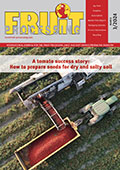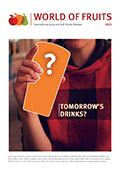U.S. concentrated orange juice imports
In April 2023, supplies from abroad of concentrated orange juice decreased by -61.3 % to 16K tons for the first time since January 2023, thus ending a two-month rising trend. In general, imports showed a deep setback. The most prominent rate of growth was recorded in December 2022 when imports increased by 206 % against the previous month. In value terms, concentrated orange juice imports declined rapidly to $48M (IndexBox estimates) in April 2023. Over the period under review, imports showed a perceptible reduction. The pace of growth appeared the most rapid in October 2022 with an increase of 130 % m-o-m.
Imports by country
In April 2023, Mexico (9.2K tons) constituted the largest supplier of concentrated orange juice to the United States, with a 56 % share of total imports. Moreover, concentrated orange juice imports from Mexico exceeded the figures recorded by the second-largest supplier, Costa Rica (4.1K tons), twofold. From April 2022 to April 2023, the average monthly rate of growth in terms of volume from Mexico amounted to -8.1 %. The remaining supplying countries recorded the following average monthly rates of imports growth: Costa Rica (-2.3 % per month) and Brazil (+12.0 % per month). In value terms, Mexico ($29M) constituted the largest supplier of concentrated orange juice to the United States, comprising 61 % of total imports. The second position in the ranking was held by Costa Rica ($11M), with a 23 % share of total imports. From April 2022 to April 2023, the average monthly growth rate of value from Mexico amounted to -5.2 %. The remaining supplying countries recorded the following average monthly rates of imports growth: Costa Rica (+0.9 % per month) and Brazil (+11.3 % per month).
Import prices by country
In April 2023, the concentrated orange juice price amounted to $2,920 per ton (CIF, US), surging by 18 % against the previous month. Overall, the import price showed a pronounced increase. The growth pace was the most rapid in July 2022 when the average import price increased by 117 % month-to-month. As a result, import price attained the peak level of $4,563 per ton. From August 2022 to April 2023, the average import prices failed to regain momentum. Average prices varied somewhat amongst the major supplying countries. In April 2023, the country with the highest price was Mexico ($3,139 per ton), while the price for Brazil ($2,507 per ton) was amongst the lowest. From April 2022 to April 2023, the most notable rate of growth in terms of prices was attained by Costa Rica (+3.2 %), while the prices for the other major suppliers experienced mixed trend patterns.
Source: IndexBox Market Intelligence Platform
All Oranges 38.2 Million Boxes
The 2021-2022 Florida all orange forecast released by the USDA Agricultural Statistics Board is lowered 3.0 million boxes to 38.2 million boxes. If realized, this will be 28 percent less than last season’s revised final production. The forecast consists of 18.2 million boxes of non-Valencia oranges (early, mid-season, and Navel varieties) and 20.0 million boxes of Valencia oranges. A 9-year regression has been used for comparison purposes. All references to “average”, “minimum”, and “maximum” refer to the previous 10 seasons, excluding the 2017-2018 season, which was affected by Hurricane Irma. Average fruit per tree includes both regular and first late bloom …
Please download the full citrus crop production forecast: www.nass.usda.gov
The PET bottle has emerged as the preferred packaging for drinks among Japanese millennials due to its ease of use and eco-friendly nature. Against this backdrop, beverage giant Suntory Beverage & Food Limited (SBF) is looking to capitalize on the growing popularity of this packaging format to drive ready-to-drink (RTD) coffee sales amid a shrinking RTD market in Japan, says GlobalData, a leading data and analytics company.
According to the company’s report: Success Case Study: Suntory Craft Boss – Craft-style ready-to-drink coffee resonates with Japan’s Millennials, Japan is the largest RTD coffee market in the world, selling 3,574 million liters in 2017. However, the market volume growth in Japan has been slow in recent years and is expected to decline at a compound annual growth rate of -0.89 % between 2017 and 2022. On the other hand, GlobalData’s Market Analyzer reveals that the percentage of sales of PET bottled RTD tea & coffee has increased by 2.81 % from 6,659.30 million liters in 2017 to 6,851.58 million liters in 2018.
Suntory launched Craft Boss, a new range of RTD coffee under the Suntory Boss brand, in April 2017. The Craft Boss range is sold in PET bottles rather than metal cans to offer new consumption experience to millennial consumers.
Shagun Sachdeva, Consumer Insights Analyst at GlobalData, says: “The company’s move to launch craft-style coffee drinks in a PET bottle format is part of strategic product positioning to tap new consumer groups, particularly millennials. This clearly demonstrates that it has understood the importance of innovation in terms of appeal and packaging format, in line with the demographic changes in Japan.”
Craft Boss PET bottled coffee series crossed 27 million cases in 2018. It was the biggest driver of Boss coffee sales, which crossed 100 million cases last year. The success of this series helped Suntory compensate decline in other products, with a very strong growth of 8 million cases in 2018 compared to the previous year.
Sachdeva concludes: “Suntory is one of the first major manufacturers to react to the slow market growth of RTD coffee in Japan. The company has quickly identified the market gap and is catering to the evolving demands of the white-collar millennials to take advantage of the appealing market segment. Simply put, the company used incremental innovation and customer-centric strategy to gain a clear, competitive edge over rivals.”
The market is estimated to be valued at USD 818.6 Million in 2017 and is projected to reach USD 1,224.2 Million by 2022, at a CAGR of 8.4 % from 2017.
Some of the major players in the market includes:
- Bosch (Germany)
- Elea Technology (Germany)
- Pulsemaster (Netherlands)
- Bühler (Switzerland)
- Hiperbaric España (Spain)
- Nordion (Canada)
- Avure Technologies (US)
- Emerson (US)
- CHIC FresherTech (US)
- Gray*Star (US)
- Dukane (US)
- Symbios Technologies (US)
By technology, HPP segment to lead the non-thermal processing market from 2017 to 2022
The HPP segment is projected to grow at the highest CAGR among all non-thermal processing technologies from 2017 to 2022. The HPP technology preserves the freshness of food products as well as aids in extending their shelf life. This technology also accommodates the current consumer demand for natural, fresh, and minimally processed foods, as no preservatives or additives are added to the products. These factors are driving the market for HPP technology in non-thermal processing.
Microbial inactivation segment projected to grow at the highest CAGR, by function, from 2017 to 2022
Microbial inactivation helps to extend the shelf life of food products and is one of the widely used functions of the non-thermal processing technology. Among all, irradiation is an effective non-thermal technology used for microbial inactivation. High frequency radiation treatment utilized in this technology leads to the disintegration of the cells of microorganisms.
North America is projected to be the fastest-growing region during the forecast period
The food industry in North America employs non-thermal technology to reduce the presence of pathogens, maintain the nutrition in food products, and ensure the safety of food products. The market for non-thermally processed food & beverage products in North America is being driven by the demand for health and wellness products as well. Major players are investing in R&D to develop innovative functional products which can be achieved by using novel technologies such as non-thermal processing. The economic downturn has changed consumer behavior significantly, compelling companies to lower prices to drive sales volumes.
Increase in demand for alternative food surface treatment technologies, increase in focus of companies on providing innovative and novel techniques, and growth of the functional foods industry are the major factors driving the growth of the North American non-thermal processing market for cold plasma technology.
Download PDF brochure: www.marketsandmarkets.com
The smaller volume of oranges allocated to processors in the 2016/17 season (due to one of the smallest crops in the citrus belt, with only 245.3 million boxes of 40.8 kilos) has affected not only orange juice exportations, but shipments of orange by-products as well. While in the 2015/16 season exportations of these products increased, shipments of all items from the crop that officially ended in June (July/16 to June/17) had the worst individual performance, mainly in terms of volume.
The revenue from by-products exportations in the 2016/17 season, however, was 390.08 million USD, 22 % up compared to the previous crop (Secex). Except for lemon and lime oil, prices of all the other by-products increased significantly in the season. These exportations include citrus pulp pellets, citrus terpenic, D-limonene, lemon, lime and orange essential oils and other citrus products.
As for the individual performance, only two by-products had higher shipments compared to the previous season: D-limonene and lemon essential oil. On the other hand, the volume of citrus pulp pellets exported decreased a staggering 68 %, totaling 68.6 thousand tons.
FCOJ – Exportations of frozen concentrate orange juice equivalent (FCOJ Equivalent) decreased 17 % compared to the previous crop. From July/16 to June/17, exportations of FCOJ Equivalent totaled 950.92 thousand tons, according to Secex. Revenue totaled 1.73 billion USD, 6 % down compared to the same period last crop. In Real, revenue totaled 5.57 billion BRL, 18 % down in the same comparison.
Brazilian exportations should increase next season, based on the partial recovery of the orange juice inventories.
BRAZILIAN MARKET – Demand for in natura oranges weakened in the second week of July, due to the mild temperatures in São Paulo State and the school vacations period. Thus, pear orange quotes averaged 16.30 BRL per 40.8-kilo box (on tree) between July 3 and 14, 7.1 % down compared to the same period in June.
Purchases from processors were limited as well. Receiving previously purchased fruits, processors from SP State did not trade much in the spot in the first fortnight of July, mainly due to maturation out of the ideal period for some fruits, mainly the mid-season ones. Thus, bidding prices continued between 16.00 BRL and 18.00 BRL per 40.8-kilo box, harvested and delivered at the processor, and between 18.00 BRL and 20.00 BRL per box for the mid-season fruits.









